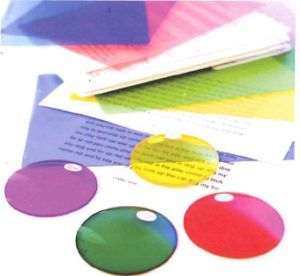
Opening times
Mon 9.30am - 5.00pm
Tue 9.30am - 5.00pm
Wed 9.30am - 5.00pm
Thur Closed
Fri 2.00pm - 5.00pm
Sat 10.00am - 1.00pm
Sun 10.00am - 4.00pm
27 High St, Walthamstow, London, E17 7AD
Tel: 020 8520 4105
Email: admin@visionwise-opticians.co.uk
Colorimetry & Visual Stress
Are you or your child struggling with reading?
Reading is a complex task requiring good vision and some complex processing in the brain. Reading difficulties may be caused by the way information is “processed” by the brain- a condition referred to as dyslexia. If you think your child may have dyslexia, the first step is to speak to their teacher or their school’s special needs coordinator (SENCO) about your concerns. They may be able to arrange for an assessment and if the diagnosis is confirmed, they may be able to offer additional support.
In some cases, reading difficulties can be caused by vision problems such as long-sightedness, astigmatism or problems coordinating the eyes. This can be ruled out by having your child’s eyes examined by an Optometrist. Eye tests are free for children under the age of 16.
If having ruled out dyslexia and checked that your child’s eyes are healthy, your child is still having problems reading, they might be one of the 20% of the population who suffers from a condition known as Visual Stress.
Visual Stress is thought to be caused by hyperactivity of certain groups of cells in the brain. This causes discomfort while looking at stripy patterns including rows of text. Sufferers often report that the words appear to move, wobble or flicker and sometimes complain of eye strain or headaches after reading.
The good news is that the symptoms can often be reduced by using a coloured overlay, coloured lenses or by changing the background colour of the screen or tablet that they are looking at.
The ReadEZ system was developed at City University London by a team led by optometrist and visual scientist, Professor David Thomson. The system is used by over 400 Opticians and in many hospitals and schools and our coloured overlays, coloured lenses and screen tinting software are now used by 1000s of people around the world.
Discover how colour can alleviate visual discomfort and help with dyslexia.
Visual stress is a term used to describe visual discomfort and perceptual distortions in the printed text, suffered by many people who struggle to read. The condition is estimated to be present in about 40 % of poor readers and in 20 % of the general population in varying degrees.
Coloured overlays can improve reading speed and accuracy. They can enable longer periods of reading free of discomfort. When they do, it is an indication that the individual may benefit from Precision Tinted Lenses. The lenses are prescribed using specialist equipment called a Colorimeter.
Recent imaging studies suggest that the symptoms of visual stress may be caused by a hyper-excitability of the visual cortex in the brain. The problem may be linked to photophobia and migraine.
Dyslexic individuals are more likely to experience visual stress than others, although visual stress is quite distinct from dyslexia and the phonological difficulties with which dyslexia is usually associated.
Many thousands of individuals who find reading tiring and unpleasant, unknowingly experience visual stress.
They have to work harder than their peers to achieve the same outcomes, often with extra tuition. Many could be helped by overlays or Precision Tinted Lenses. It is therefore essential that every child who struggles to read is referred to a vision practitioner who can undertake a full eye examination and check for the presence of visual stress.
A diagnostic process has been designed that allows for the identification of visual stress, thereby distinguishing it from other barriers to reading. This is achieved by the simple selection of an optimum coloured overlay placed over the reading matter.
The Signs and Symptoms of Visual Stress
All or some of the following may be present:
-
Movement of the printed text
-
Patterns in the print (described as rivers or worms)
-
Tiring easily whilst reading
-
Headaches or visual discomfort
-
Using finger as a marker on the page
-
Frustration and low self-esteem
-
Migraine

Colour can make a significant difference to the quality of life for migraine sufferers.
Migraine is often associated with a sensitivity to glare, and most patients are photophobic during an attack. The glare sensitivity occurs in response to bright lights and bold geometric patterns, particularly those of stripes. The sensitivity is associated with an abnormally strong response in the visual cortex of the brain.
Both the brain abnormality and the sensitivity are reduced by Precision Tinted Lenses. Other coloured lenses are without beneficial effect. Occasionally the Precision Tinted Lenses prevent migraine attacks. More usually they enable patients to continue their daily activities despite attacks and to cope in environments that would normally make them seek out dark rooms.


Coloured Overlays
An essential aid for vision professionals as the first step in identifying Visual Stress.
Coloured Overlays are used widely both in the classroom and by vision professionals in practice. Moderate to significant improvements in both reading rate and accuracy are not uncommon when the optimum overlay is prescribed. Overlays are coloured sheets of robust transparent plastic that are placed over a page of text when reading. The assessment pack consists of 12 overlays of different colours. The colours have shades that differ systematically. The variety of shades is sufficient to provide a shade optimal for each individual. Assessment involves the presentation of each overlay in turn for comparison with others placed beside it. The assessment can be carried out by our specialised vision professional.
The Overlay Testing Set includes the Wilkins Rate of Reading Test, which measures reading speed independently of language comprehension. It quantifies the improvement in reading.



